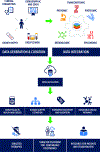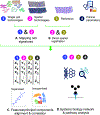Precision Medicine in Nephrology: An Integrative Framework of Multidimensional Data in the Kidney Precision Medicine Project
- PMID: 37839688
- PMCID: PMC10922684
- DOI: 10.1053/j.ajkd.2023.08.015
Precision Medicine in Nephrology: An Integrative Framework of Multidimensional Data in the Kidney Precision Medicine Project
Abstract
Chronic kidney disease (CKD) and acute kidney injury (AKI) are heterogeneous syndromes defined clinically by serial measures of kidney function. Each condition possesses strong histopathologic associations, including glomerular obsolescence or acute tubular necrosis, respectively. Despite such characterization, there remains wide variation in patient outcomes and treatment responses. Precision medicine efforts, as exemplified by the Kidney Precision Medicine Project (KPMP), have begun to establish evolving, spatially anchored, cellular and molecular atlases of the cell types, states, and niches of the kidney in health and disease. The KPMP atlas provides molecular context for CKD and AKI disease drivers and will help define subtypes of disease that are not readily apparent from canonical functional or histopathologic characterization but instead are appreciable through advanced clinical phenotyping, pathomic, transcriptomic, proteomic, epigenomic, and metabolomic interrogation of kidney biopsy samples. This perspective outlines the structure of the KPMP, its approach to the integration of these diverse datasets, and its major outputs relevant to future patient care.
Keywords: Acute kidney injury; chronic kidney disease; precision medicine.
Copyright © 2023 National Kidney Foundation, Inc. Published by Elsevier Inc. All rights reserved.
Conflict of interest statement
Figures


References
-
- United States Renal Data System. 2022 USRDS Annual Data Report: Epidemiology of kidney disease in the United States 2022. https://adr.usrds.org/2022 - PMC - PubMed
Publication types
MeSH terms
Grants and funding
LinkOut - more resources
Full Text Sources

